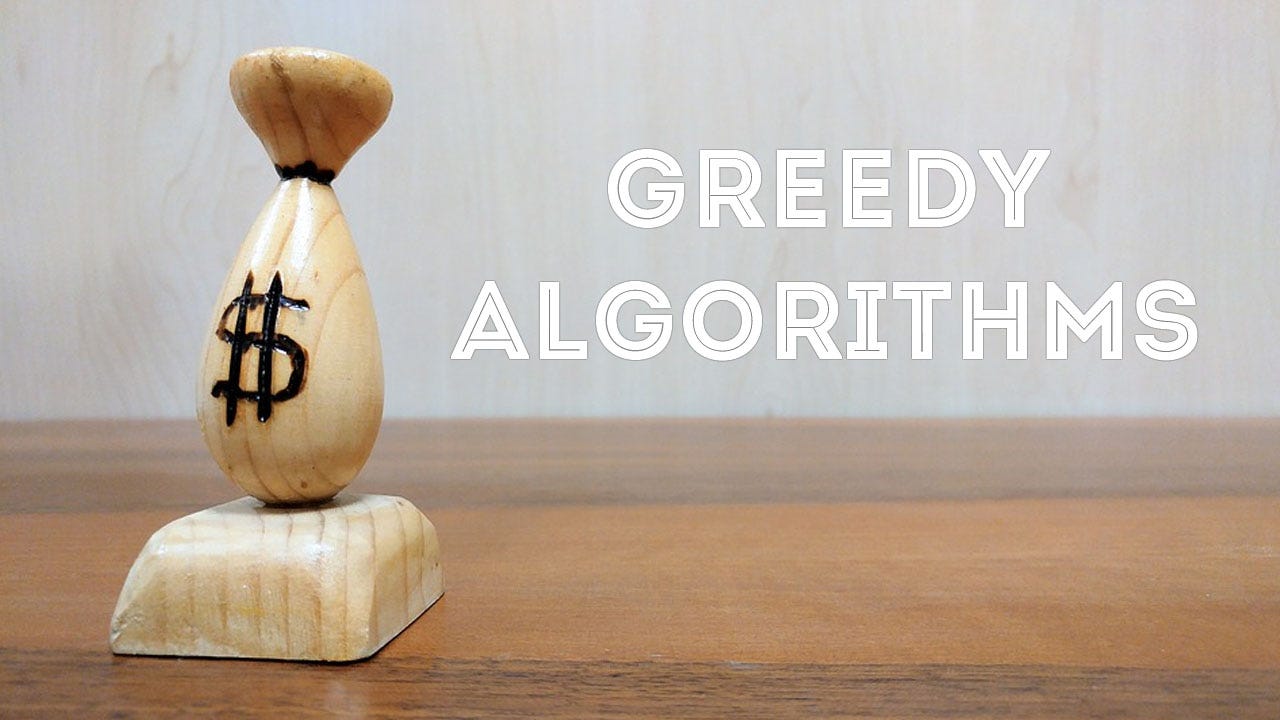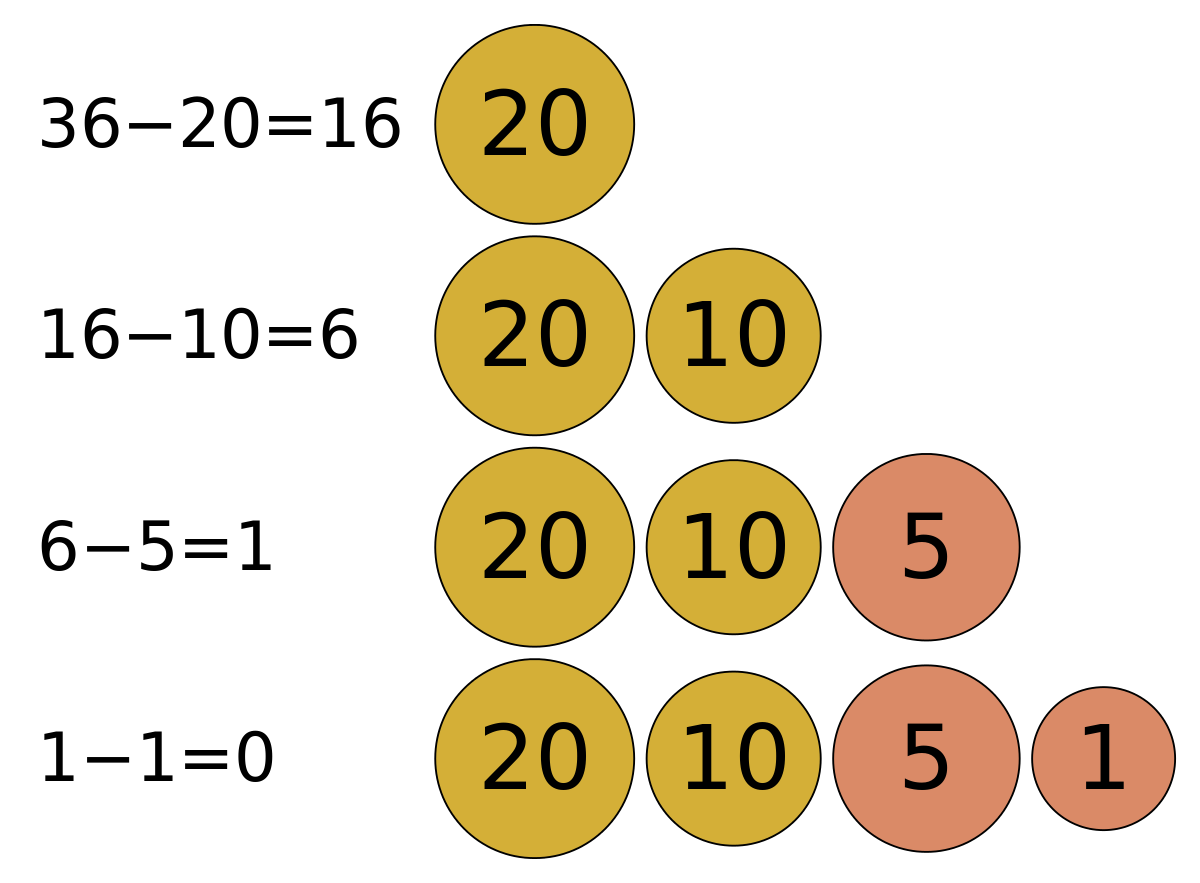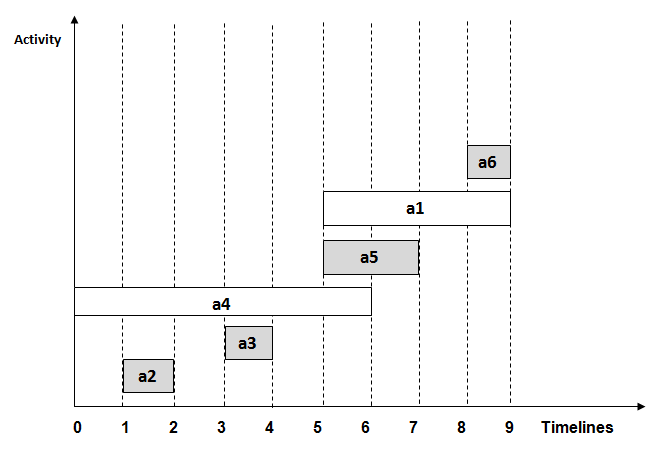Greedy algorithms
Any algorithm that
follows the problem-solving heuristic of choosing the locally best option at
each stage is known as a greedy algorithm.
A greedy strategy may not produce an optimal solution in many cases, but
it can produce locally optimal solutions that approximate a globally optimal
solution in an acceptable amount of time.
As the name implies, a
greedy algorithm always chooses the option that appears to be the best at the
time. This means it will make a locally optimal decision in the hopes of
arriving at a globally optimal answer.
For example, a greedy
strategy for the travelling salesman problem (which has a high computing cost)
is to "visit the nearest unvisited city at each step of the route. This heuristic does not aim to discover the best answer, but it
does it in a fair number of steps; finding the best solution to such a
difficult problem usually takes an unreasonable amount of time. Greedy methods
are used in mathematical optimization to solve combinatorial problems with
matroid qualities and to yield constant-factor approximations to optimization
problems with the submodular structure.
Greedy Approach
1. Let's
start with node 20 (the root). The right youngster weighs 3 pounds, whereas the
left child weighs 2.
2. Our
goal is to discover the longest path possible. And, at the moment, the best
solution is 3. As a result, the greedy algorithm will pick number three.
Finally, the weight of a three-year-old lone child is 1. As a result, our final
answer is 20 + 3 + 1 = 24.
It is, however, not the best option. As seen in the graphic below,
there is another method that bears greater weight (20 + 2 + 10 = 32).
Greedy algorithms are
classified as "short-sighted" and "non-recoverable."
They're only useful for problems with a 'optimal substructure.' Despite this,
the best-suited algorithms for many simple problems are greedy. It's worth
noting, however, that the greedy algorithm can be employed as a
branch-and-bound method or a selection algorithm to rank choices inside a search.
The greedy algorithm has a few different variations:
·
Pure greedy algorithms
·
Orthogonal greedy algorithms
·
Relaxed greedy algorithms
Standard Greedy
Algorithms:
1.Activity
Selection Problem
Greedy is an
algorithmic paradigm that assembles a solution piece by piece, constantly
opting for the next component that provides the most evident and immediate
benefit. For optimization issues, greedy algorithms are used. Greedy can solve
an optimization problem if it has the following property: At each stage, we can
select the best choice that looks best at the time, and we receive the best
solution for the entire problem.
If a Greedy
Algorithm can solve a problem, it is usually the optimal approach for doing so
since Greedy algorithms are more efficient than alternative techniques like
Dynamic Programming. However, greedy algorithms are not always applicable. The
Fractional Knapsack problem, for example, can be solved with Greedy, whereas
the 0-1 Knapsack problem cannot.
The following
are some examples of standard greedy algorithms.
2) Prim's minimum spanning algorithm: We generate an MST by picking edges one by one in Prim's algorithm
as well. We keep two sets of vertices: one for those that are already in MST
and another for those that aren't yet. Picking the smallest weight edge that
connects the two sets is the Greedy Option.
3) Dijkstra's Shortest Path: Dijkstra's and Prim's algorithms are quite
similar. Edge by edge, the shortest-path tree is constructed. We keep two sets
of vertices: one for those that have already been added to the tree, and
another for those that have not yet been added. The Greedy Choice is to choose
the edge that connects the two sets and is on the shortest weight path from the
source to the set with vertices that have not yet been included.
4) Huffman Coding: The Huffman Coding Method is a lossless compression method. It
assigns distinct characters variable-length bit codes. The Greedy Option is to
assign the character with the shortest bit length code.
For Hard optimization
issues, greedy techniques are sometimes utilised to gain an approximation. The
Traveling Salesman Problem, for example, is an NP-Hard problem. At each stage,
a greedy solution to this problem is to choose the next unvisited city from the
current city. These solutions do not necessarily yield the best ideal solution,
but they can be utilised to obtain a close match.
Time Complexity: It takes O(n log n) time if input
activities may not be sorted. It takes O(n) time when it is given that input
activities are always sorted.
Knapsack problem
The
knapsack problem is a combinatorial optimization problem that entails:
Determine the quantity of each item to include in a collection given a set of
objects, each with a weight and a value, so that the total weight is less than
or equal to a given limit and the total value is as large as possible. It gets
its name from the issue that someone with a fixed-size knapsack faces when they
have to fill it with the most precious stuff. The issue frequently arises in
resource allocation, as decision makers must choose among a set of
non-divisible projects or activities while working under a strict budget or
time constraint.
The knapsack problem has
been investigated for almost a century, with the first papers dating back to
1897. The term "knapsack problem" is derived from the early works of
mathematician Tobias Dantzig (1884–1956), and relates to the challenge of
packing the most expensive or helpful objects without overcrowding the luggage.
2. Job Sequencing Problem
Given a
list of jobs, each with its own deadline and related profit if completed before
the deadline. Given that each activity takes a single unit of time, the
shortest deadline conceivable for any job is 1. When just one work can be
booked at a time, how can overall profit be maximised? A simple solution is to
produce all subgroups of a given set of jobs and then examine the feasibility
of jobs in each subset individually. Maintain a running total of the greatest
profit from all possible subgroups. This solution has an exponential temporal
complexity.
This is
a typical Greedy Algorithm scenario. The Time Complexity of the above solution is
O(n2). It can be optimized using Priority Queue(max heap).
The algorithm goes as follow:
·
Sort the jobs based on their deadlines.
·
Iterate from the end and calculate the available
slots between every two consecutive deadlines. Include the profit, deadline,
and job ID of ith job in the max heap.
·
While the slots are available and there are jobs
left in the max heap, include the job ID with maximum profit and deadline in
the result.
·
Sort the result array based on their deadlines.
3. Greedy Algorithm for Egyptian Fraction:
Every
positive fraction can be expressed as a collection of distinct unit fractions.
If the numerator is 1 and the denominator is a positive integer, the fraction
is called a unit fraction. For example, 1/3 is a unit fraction. Egyptian
Fraction was the name given to this type of representation since it was
employed by ancient Egyptians.
Using the Greedy Algorithm, we can construct Egyptian
Fractions. Find the highest feasible unit fraction for a given number of the
type 'nr/dr' when dr > nr, then repeat for the remaining part. Taking 6/14
as an example, we first determine a ceiling of 14/6, i.e. 3. As a result, the
initial unit fraction becomes 1/3, and the process repeats for (6/14 – 1/3), or
4/42. Because a fraction is always reduced to a form where the
denominator is bigger than the numerator and the numerator does not divide the
denominator, the Greedy algorithm works. The highlighted recursive call for
decreased numerator is made for such reduced forms. As a result, the recursive
calls continue to reduce the numerator until it approaches 1.
4. Efficient Huffman Coding for Sorted Input:
The
above-mentioned algorithm has an O time complexity (nLogn). We can create
Huffman codes in O(n) time if we know the provided array is sorted (in
non-descending order of frequency). For sorted input, here is an O(n)
algorithm.
1.
Begin by making two empty queues.
2. For
each unique character, create a leaf node and enqueue it to the first queue in
non-descending order of frequency. The second queue is initially empty.
3.
Examine the front of both queues to dequeue two nodes with the lowest
frequency. Repeat the procedure two more times.
1.
Dequeue from first queue if second queue is empty.
2.
Dequeue from second queue if first queue is empty.
3. If not, compare the fronts of two queues and dequeue the
one with the shortest wait time.
4. Make
a new internal node with the frequency of the two nodes added together. Make
the left child of the first Dequeued node and the right child of the second
Dequeued node. Add this node to the second queue.
5. If there are multiple nodes in the queues, repeat steps
#3 and #4. The root node is the last node in the tree, and it completes it.
Applications
Greedy algorithms frequently (but not always) fail to identify the globally optimal solution because they do not run through all of the data exhaustively.
They may make premature commitments to certain options, preventing them from later determining the greatest overall answer.
For example, none of the existing greedy colouring algorithms for the graph colouring problem or any other NP-complete problem consistently provide optimal solutions.
Nonetheless,
they're useful because they're quick to come up with and frequently provide
good approximations to the ideal.
If a greedy algorithm can be shown to generate the global optimum for a specific problem class, it is often chosen over alternative optimization approaches such as dynamic programming since it is faster.
Kruskal's and Prim's
algorithms for finding minimum spanning trees, as well as the technique for
finding optimum Huffman trees, are examples of greedy algorithms.
Examples
- The activity selection problem is typical of this type of problem, in which the goal is to select the greatest number of activities that do not conflict
- Crystal Quest is a Macintosh computer game in which the goal is to collect crystals in a manner similar to the travelling salesman dilemma. In the demo mode, the game uses a greedy method to visit all of the crystals. Because the artificial intelligence fails to account for obstructions, the demo mode frequently terminates prematurely.
- The signal approximation matching pursuit is an example of a greedy algorithm.
- Greedy algorithms are often employed in decision tree learning, although they are not guaranteed to find the best solution.
- For decision tree creation, one prominent approach is the ID3 algorithm.
- For graph search and shortest path finding, Dijkstra's algorithm and the related A* search algorithm are verifiably optimum greedy algorithms.
- o An "admissible heuristic" that does not overstate path costs is required for A* search to be conditionally optimal.
- • Kruskal's and Prim's algorithms are greedy methods for constructing the shortest spanning trees in a linked network. They always find the best solution, which may or may not be unique.
It is best applicable when one needs a solution in real-time and approximate answers are “good enough”. Clearly, it minimizes time while making sure that an optimal solution is produced; hence it is more applicable to use in a situation where less time is required. Post-reading this article, one might have a fair idea about greedy algorithms. In addition, this post explains why it is regarded as the best framework that answers nearly all programming challenges along with helping you to decide the most optimal solution at a given point in time.
However, on the rough side, for applying the theory of greedy algorithms, one must work harder to know the correct issues. Although it’s a scientific concept that has logic, it also has an essence of creativity.






Informative👍👍
ReplyDeleteWell done 💯
ReplyDeleteGood work keep it up
Nice work 👍✌️
ReplyDeleteVery informative
ReplyDeleteMast
ReplyDeleteVery informative
ReplyDeleteNice blog
ReplyDeleteWell done, thanks🤝
ReplyDeleteThis is greatt !!!
ReplyDeleteVery helpful blog
ReplyDeleteNice work 👍
ReplyDeleteInformative
ReplyDeletelooking forward for your next blog
ReplyDeleteWell done👍🤝
ReplyDeleteHelpful
ReplyDelete